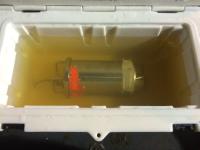
El Faro voyage data recorder in fresh water on the USNS Apache Photo: NTSB
A National Transportation Safety Board (NTSB) press release announced today that the voyage data recorder (VDR) from El Faro, the US flagged cargo ship that sank during Hurricane Joaquin in October 2015 with the loss of all 33 aboard, was successfully recovered from the ocean floor late Monday evening.
The VDR was located last April by the research vessel Atlantis in 15,000 feet of water, about 41 miles (36 nautical miles) northeast of Acklins and Crooked Islands, Bahamas, but could not be retrieved with the equipment aboard the ship. Military Sealift Command’s fleet ocean tug USNS Apache with personnel from the NTSB, the U.S. Coast Guard, the U.S. Navy and Phoenix International aboard arrived at the accident location on Monday morning. Technicians maneuvered CURV-21, a deep ocean remotely operated underwater vehicle to the the wreckage of El Faro to extricate the VDR capsule from the mast structure to which it was attached. The VDR was brought aboard the ocean tug at about 10:30 pm Monday evening.
From the NTSB press release:
The recovery of the capsule caps a 10-month-long effort to retrieve the recorder, which was designed to record navigational data and communications between crewmembers on the ship’s bridge. Investigators hope the recorder will reveal information about the final hours of El Faro’s voyage and the circumstances leading up to the sinking.
“The recovery of the recorder has the potential to give our investigators greater insight into the incredible challenges that the El Faro crew faced,” said NTSB Chairman Christopher A. Hart, “but it’s just one component of a very complex investigation. There is still a great deal of work to be done in order to understand how the many factors converged that led to the sinking and the tragic loss of 33 lives. I want to thank the dedicated professionals in the many organizations — especially the U.S. Navy, the Coast Guard, Woods Hole Oceanographic Institute, the National Science Foundation and the University of Rhode Island — who worked with NTSB investigators and support staff over three missions in 10 months to make this successful recovery possible,” said Hart. …
The voyage data recorder will be examined while at sea by NTSB investigators aboard the USNS Apache, to assess the condition of the device and to ensure proper preservation for readout and further examination ashore. The VDR will be transported to the NTSB’s laboratory here after the Apache returns from sea on or about Aug. 12, 2016. Once at the NTSB’s lab a team of specialists will audition the recording. It is not yet known how long it may take to review the data and audio information that may be captured on El Faro’s VDR. While the minimum design requirement for VDRs of this type is for 12 hours of recording, it may contain additional information — the review of which is a thorough and time consuming undertaking. NTSB will provide updates as investigators learn more about the condition and contents of the El Faro’s VDR.
While investigators examine the VDR, additional photo- and video-documentation of the El Faro wreckage and debris field will be completed today concluding NTSB’s activities at the site. No further missions to the accident site are planned unless warranted as the investigation continues.
Additional information about this investigation is available on the NTSB’s El Faro webpage.
Contact: NTSB Media Relations
490 L’Enfant Plaza, SW
Washington, DC 20594
Christopher O’Neil
(202) 314-6133
christopher.oneil@ntsb.gov

This is excellent news. Is it not remarkable that when something really has to be achieved the equipment, vessel, and people can be found to do the job. From 15,000 feet is quite amazing.
Good Watch.
Yet they still haven’t found Malaysia Airlines Flight 17 (MH17/MAS17?